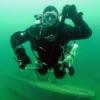Kamala, the benefits of enriched air have been known for a LONG time. The military and commercial divers have been enjoying the benefits for more than 50 years. If you mean why did THEY start doing it, well simple. It was beacause the workers or military divers could dive longer and do more work in relative safety. If you mean how did it come to pass that recreational divers were using it, thank NOAA for experimenting and bringing it to the forefront. They (amongst others) took away the voodoo effects of breathing enriched air.
We talked a lot about this in my Adv. Nitrox class but to be honest, I was far more interested in learning the gas laws. I'd suggest picking up a copy of the NOAA diving manual, and Kevin Gurr's book if you want to delve further into this stuff.
Thanks Perrone that is good information. Curious if they started using nitrox to work longer were they limited by the MOD limitations?
One thing... The British and US military lost a fair portion of their divers (UDT types) to ox tox because of the work involved in laying mines and such. This was a "hazard of the job" during WWII.



















